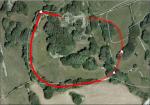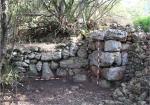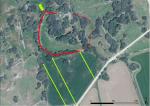Summary (English)
In 2015’s campaign, we conducted an intensive archaeological excavation in Torrellafuda (Ciutadella) in the context of the works carried out for the identification and characterization of possible Phoenician-Punic influence in the architecture of the island. This campaign concluded the topographical survey, archaeological analysis of the walls and photogrammetry works started on the previous campaign.
The goal of these works was to obtain material evidence to confirm the historical sequence proposed by various authors for the site and to assess how much of the sequence belongs to the period to which we attribute the elements of Punic-Hellenistic military architecture observed in places such as Trepucó, Son Catlar or Torrellafuda.
The settlement of Torrellafuda, declared heritage asset or BIC in 1966, is located in the western part of the island; 7 km to the east of the Ciutadella, and is linked to the main communication axis of Menorca. Besides, it is quite close to other settlements that seem to have had the very same historical sequence; Torretrencada and Son Catlar.
Torrellafuda, inhabited since the Talayotic period through the Post-Talayotic and Roman periods, was apparently unoccupied during the Late Antiquity and it was, once again, occupied during the Al-Andalus period. Even though the visible remains are scarce, it is one of the most emblematic sites on the island due to its taula enclosure which is immersed in lush vegetation and its imposing walls, elements that award the site a unique character.
While the site has not been subject to systematic surveys, occasional works have been carried out since the middle of the last century, including the gathering of materials, which provides information on its chronology.Through the archaeological analysis of the walls conducted, we have established the existence of two ancient-times phases in the wall, followed by different modern repairs. The first cyclopean phase (comprising vertical foundationless orthostats) is overlapped by what we consider to be a reinforcement work that follows Punic-Hellenistic guidelines, by means of the construction of strongholds and sally ports as well as a potential glacis.
The works carried out in 2015 are divided in two; the topographical survey of the wall, and the intensive excavation through the gathering and geolocation of surface materials outside the settlement. The quantity of ceramic fragments retrieved is specially astonishing, most of them date back to the 3rd century B.C. and 1st century A.D. The most repeated are Punic-Ebusitan and Greco-Italic amphorae, followed by those from Tarraco. Then, Campanian pottery, and Italic and South Gaulish sigillata. There is also a great number of common Iberian, Tarraconensis, Italic and Punic pottery. And, although not found on our excavations, the presence of Ebusitan coins and lead projectiles (or glandes) has been documented.
The set of earliest materials seems to be the usual in Punic contexts from the 3rd century B.C., as observed in other examples from the Iberian Peninsula. Despite the limitations of the works, we push the hypothesis that it is a context of the Second Punic War, and, therefore, linked to Mago and his troops’ time on the island in 206-205 B.C.
(translation by Himar González González)
- Helena Jiménez Vialás et al.
Director
- Fernando Prados Martínez
Team
- Helena Jiménez Vialás, Joan C. de Nicolás Mascaró, Andrés María Adroher Auroux, Octavio Torres Gomariz, José Javier Martínez García, Iván García Jiménez, Diego López Martínez, David Expósito Mangas, Sonia Carbonell Pastor
Research Body
- Universidad de Alicante
Funding Body
- Ajuntament de Ciutadella
- Camping Cap Blanch
- Consell Insular de Menorca
- Ministerio de Economía y Competitividad (RYC 2011-08222)
- Societat Històrico-Arqueològica Martí i Bella






![Download [PDF]](/excavation/skins/fasti/images/results/download_sml.png)


